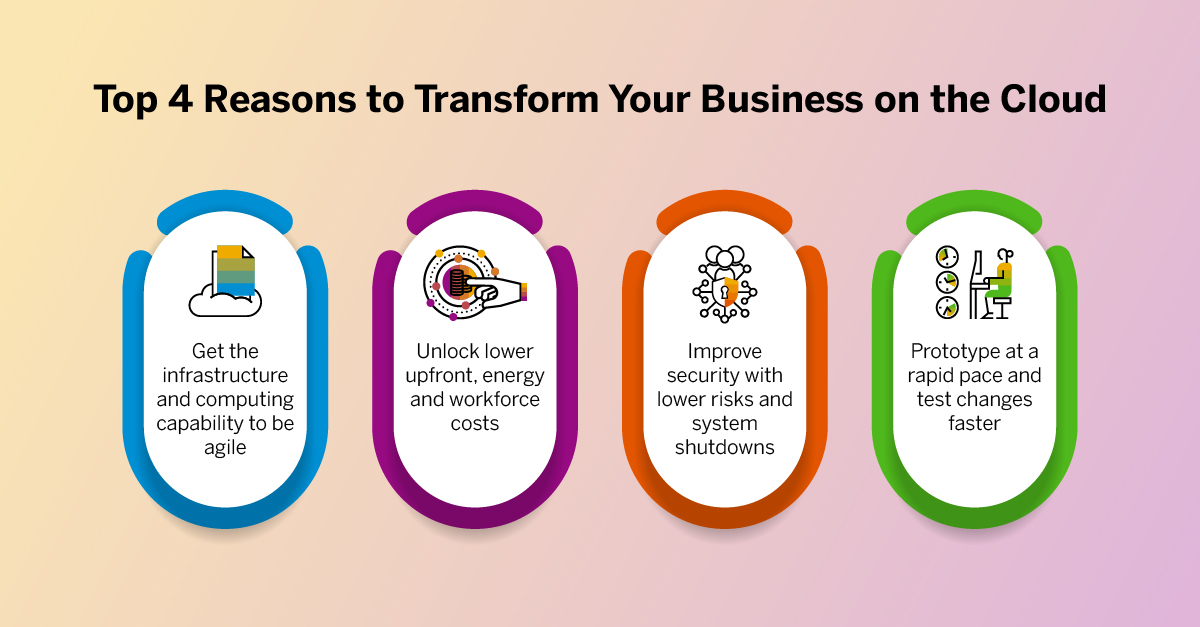Do you want your business to report stronger growth and increased efficiency? Are legacy systems holding back your aim of digital business transformation? Consider moving your legacy system to cloud infrastructure for better growth and efficiency. Moving to the cloud can make your system ready for digital business transformation and reap faster growth, among other benefits.
The key reasons to move to the cloud include:-
- Agility- As per a Mckinsey report, the agility of an organization has become more important due to disruptions like Covid and supply chain issues. An organization that can reinvent its business model has a much higher chance of staying relevant in an increasingly complex, ever-changing world. By moving to the cloud, you can get the required platform, infrastructure, and computing capability to become agile.
- Lower costs- One of the most significant benefits of moving your system to the cloud is the accrual of cost benefits because of the following reasons: –
- No requirement of a dedicated server- Your hardware demand for storage becomes linked to your scale of business. You will no longer own physical storage. You can scale as and when your business scales to pay as you go rather than spending upfront on a dedicated server.
- Lower energy costs- It is well known that idle servers consume electricity, and when you store applications on the cloud, you no longer need to pay for idle servers.
- Lower workforce costs- Maintaining a data server requires high-quality IT staff, which is expensive. If you move to the cloud, you don’t need dedicated staff to maintain your data server and it is effectively outsourced to the cloud service provider.
- No upfront costs- Setting up a dedicated server requires upfront costs. These upfront costs can disrupt your cash flow. Whereas, if you spend on a cloud-based infrastructure, you can pay as per the requirement without any upfront commitment from your side, thus making your organization more adaptable to change as per the requirement of IT infrastructure.
- Security- As per Rapidscale, 94% of cloud adopters believe it to be more secure. Benefits range from a lower risk of data breach and less chance of system shutdowns or system failures.
- Faster Prototyping- Being able to develop a prototype at a rapid pace and test its success will help organizations decide whether they want to go ahead with implementation. A cloud-based IT infrastructure can help the organization prototype and test the changes faster. This can make an organization more nimble by reducing the time to change.

Despite all the apparent advantages of cloud-based IT infrastructure, as per Statista, only 50% of all corporate data is stored in the cloud as of July 30, 2021. This has increased from 30% in 2015. If you want your organization to successfully migrate most data to the cloud, you require coordination of different teams and particular focus from the CIO, CTO and CEO. To ensure business transformation on the cloud, the following steps should be considered to get a robust and efficient system that can continue in the future as well: –

- Establish Responsibilities- Before migrating your data to the cloud, make sure your team understands the responsibilities and chief architects of the change. Such a team will be set up on consultations with the CEO, CIO and CTO, the key stakeholders and decision-makers in the cloud migration journey. This team should now be responsible for planning and executing the migration. Migration priorities and benefits should be established after due consideration.
- Shallow cloud integration v/s Deep cloud integration-
Shallow Cloud Integration
Deep Cloud Integration
Application is moved to the cloud on an as-is what is basis.
Application is changed during the migration.
Move the application to the cloud with little or no change at all.
Migration is done to take advantage of cloud capabilities, and therefore change is necessary.
Does not affect the business results
Can help business results if it is done right. Automation and scalability can be enhanced by using cloud infrastructure.
- Establish KPIs for cloud migration- The key performance indicators should be established to understand the possible benefits and how to realize those benefits. With a clear goal in mind, the chance of successful migration is much better. For example, if you want to enhance the user experience, an important KPI can be Page Load Time, Lag, response time, etc. Similarly, if you want to increase sales, important KPIs can be cart additions, conversion rate, engagement rate, etc. Thus, if you can define the key indicators, goal attainment can be much easier.
- Determine the readiness of your organization- Once you are clear of the benefits and KPIs you would like to achieve, you should check if your legacy system is ready for cloud migration. If your organization does not have the relevant IT talent, you can hire a consultant to check cloud readiness. Most legacy systems are not cloud-friendly and use several in-house applications to fetch data. This can be a hurdle when moving to the cloud, as these applications will require higher online capacity.To ensure a smooth migration, follow the following steps: –
- List your applications.
- List the servers, hardware, and storage these applications are using.
- Collect the use case of these applications from respective application heads/users.
- Prepare dependency maps or flowcharts.
- Analyze each application to prepare cloud migration plans and disentangle dependencies wherever possible.
- Choose a cloud service provider- The right service provider depends on your specific requirements, although some top organizations provide most of the features. Nevertheless, you should be willing to get a detailed understanding of the benefits each cloud service provider can give and then choose accordingly. Some of the factors to be considered are as follows: –
- Time to market- A good enterprise cloud software should allow code to be written iteratively to enable automation. A quick response to market demand requires enterprises to have automated analytics cloud platforms. Automation allows the release of new capabilities faster, thus ensuring a shorter time to market. The enterprise cloud software should be automation-friendly.
- Innovation- A good cloud infrastructure should provide access to third-party applications to support innovation. Access to a third-party ecosystem ensures advanced technologies like data aggregation, quantum computing, facial recognition, and natural language processing.
- Lower security risk- Cloud infrastructure service providers can invest billions of dollars in cyber security. Thus, cyber security capabilities should be considered at the time of system selection for the cloud. Analytics cloud systems should be secure against cyber-attacks and other security threats.
- Scalability- A good enterprise cloud software should allow scalability to respond to peak demand and uncertain business climate, especially in situations like Covid-19 disruptions. The cloud software should be scalable in seconds as the demand for usage increases. If the cloud is scalable, the business can be scaled without worrying about technology disruptions caused due to changing business environment. Competitiveness in the industry favors technologically scalable companies.
- Costs and Risks- Before selecting the correct enterprise cloud software, you should list down all the costs and risks you are taking up. Remember, migrating to the cloud can be cost-intensive initially, depending on the size and data of the organization. You should first list down all the risks in the following categories: –
- Compliance risks
- Cybersecurity Risks
- Vendor Risk
- Cloud migration risk
A cost-benefit analysis should be done after the migration team quantifies all the risks.
- When finalizing your analytics cloud software, decide whether you desire Infrastructure as a Service(Iaas), or Platform as a Service(Paas), or Software as a Service(Saas). You should decide which one to use based on business requirements, business size, and scale. This decision should make use of business managers as well.
|
Infrastructure as a Service(Iaas) |
Platform as a Service(PaaS) |
Software as a Service(SaaS) |
|
Cloud-based services, pay-as-you-go for services such as networking, storage, and virtualization. |
Software and hardware tools available over the internet |
Software provided by a third-party over the internet |
|
Eg. AWS EC2, Rackspace, Google Compute Engine (GCE) |
Eg. AWS Elastic Beanstalk, Heroku, Windows Azure |
Eg. Google Apps, Salesforce, MailChimp, Dropbox, BigCommerce |
|
Useful to businesses of all shapes and sizes. It is highly flexible, scalable, and cost-effective with pay-as-you-go model. |
Provides software and hardware tools over the internet. Developers can use these tools to develop applications. Users are primarily developers. |
Even the software is run over the internet, and you don’t need to manage any of the tasks. The advantage is the ease of setting up and customer service etc. is ready in a few hours. |
- Prepare a cloud migration roadmap- After you have finalized the cloud service provider, you should prepare a migration roadmap with the help of the CIO, CTO, and cloud service provider. The migration can be one-time or incremental, depending on various factors. The advantage of incremental migration is that you can see some benefits accruing before you embark on more expenditure. If you can measure benefits, higher budget allocation is possible as the business gets involved in cloud migration.
- Changing the DNA of the organization to become cloud-ready- If the cloud is integrated into the DNA of the organization, the culture of the organization will become aligned to cloud migration. This can get enhanced cooperation from all employees and thus a higher chance of adoption. This can be done as follows: –
- Change the thinking from projects to products- The IT Team should consider application functionality as a product that can solve a particular problem like Billing, Vendor Registration, Vendor Payments, etc. Thus, if the thinking of the IT team is product-based, cloud technologies can help automate various processes and thereby help the organization save time and money.
- Developer Experience- The technology development process should be redesigned end-to-end to make cloud-native experience possible for developers. This will help the organization to stay technologically relevant and solve technical problems in a cloud environment.
- Cloud should be abstract and automation-friendly- Complex dependencies should be avoided to ensure that the software is abstract and can be applied to various environments across different business segments. For example, the marketing cloud software should not reference the HR Cloud software. If the software is free of legacy dependencies, automation is possible, and the full benefit of cloud infrastructure can be realized.
- Business Integration- The technology team should be integrated with the business team and should solve the problem from a business perspective. If the technology team understands the business, they are more likely to offer solutions that can help the business achieve better automation of various processes. Business engagement is essential in the following areas: –
- Budgeting- The budgeting is usually not from the technology team’s perspective. Budgeting is more likely to reflect business wants rather than technology wants. For example, the business requirement is more likely to be prioritized over automation spending. Automation spending can likely reduce technological costs in the future. Therefore, if possible, the business should be integrated at the budgeting level to ensure technological automation spending is not relegated.
- Collaboration-To extract full value from cloud systems, the business team should understand how to extract the value. Therefore, if there is a collaboration between the business and technology teams, the benefit of cloud migration is likely.
- Engineering Talent- Legacy companies have rigid hiring practices and getting a budget for cloud-specific IT talent is difficult. If the business is directly involved in cloud migration, specialized cloud technology and automation talent can be hired, which can help the business succeed in the long term.
Business transformation on the cloud is becoming necessary and you should check out all the available service providers to help you in your journey to success. If you are looking for marketing cloud software or general enterprise cloud software, you can consider SAP. SAP has an established reputation as an industry leader and can help your organization stay ahead.



